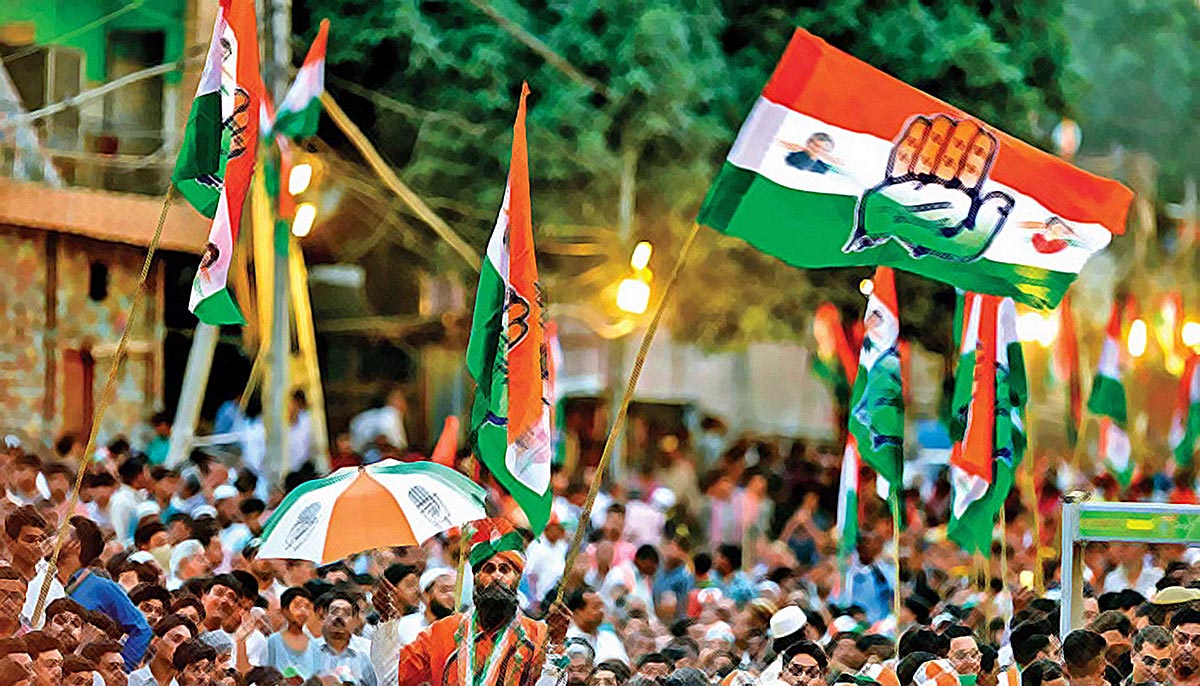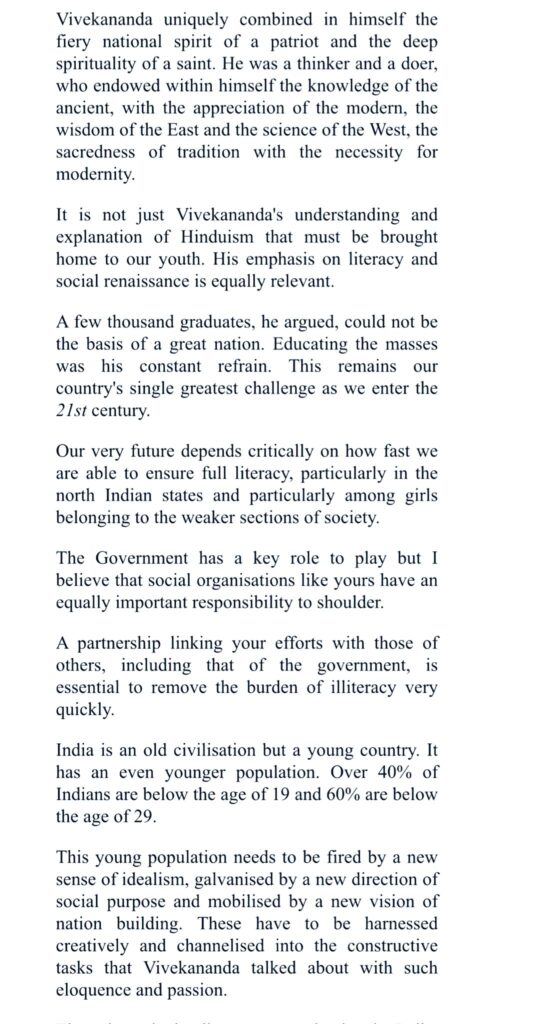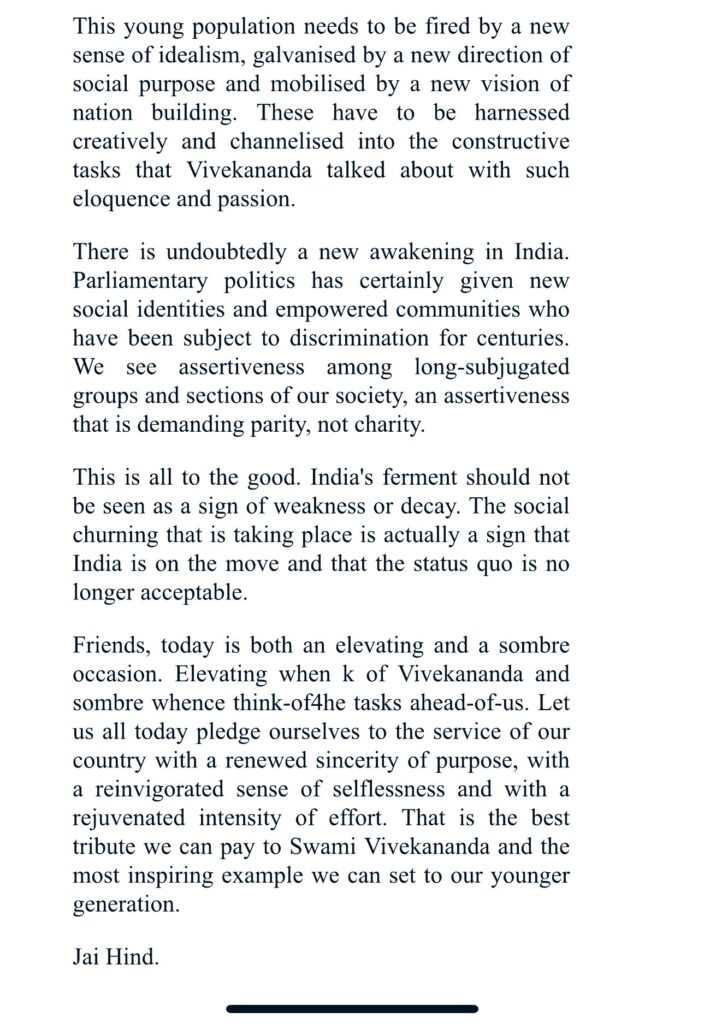Temple trotting visits periodically by the scions of the Gandhi family, both Priyanka and Rahul Gandhi, are not enough for the hardliners who have attempted a dominance of the ‘Ram Temple’ inauguration to dominate both the political and social discourse for months preceding the next general elections due in April-May 2024.
So, when the Congress leadership, on January 10, 2024, in a carefully worded statement politely declined to attend the inauguration of the unfinished Ram Temple on January 22, 2024 at the north Indian town of Ayodhya, stating this was an RSS-BJP event, it drew the predictable Sangh-BJP driven diatribe. Never mind the fact that organised Hinduisms four Shankaracharyas have unequivocally announced their decision to skip Ram Mandir consecration ceremony in Ayodhya, and have, moreover stated that the event is being held ‘against the shastras.”
The Congress’ stand, belated as it may have been, was clear. Representatives would certainly pay respects individually at some later date but not on January 22. If there was a single issue that was left unsaid –the elephant in the room so to speak –is the sheer bloodshed and demonizing that has underlain the RSS-BJP-VHP campaign behind Ram temple and Ayodhya. It has never really been about religion or personal faith but the aggressive and violent methods used to galvanise a section of the population (at last count 37 %) to validate attacks on lives and properties of fellow Indians who belong to another faith, Muslims.
“Kan kan mein vyape hai Ram, Mat Bhadkaon Danga lekar unka naam” was an evocative poster line in the mid 1980s coined by the Delhi-based Sampradayikta Virodhi Andolan in response to the violent “Garv se kaho hum Hindu hai. (Say with pride that we are Hindus)” (some Mumbaikars had come up with “Prem se kaho hum Insaan hai” at the time as well). The poster line says, Ram infuses all aspects of our lives, Do not instigate riots invoking His name. The poster line draws the single most crucial line of difference between say what Congress should be saying in response to the violent aggressive cries of the RSS-BJP: Spirituality and faith are personal, not always rational but true, organised, politicization of this, invoking violence and hate in the name of faith icons, is a recipe for disaster.
Is this language of outreach or inclusion –to an alienated and fractured population –missing from the present Congress response?
The fact that the RSS-BJP’s Narendra Modi-driven orchestrated event is being planned months before a general election (April-May 2024) when the present regime faces a population restless with rising prices, unemployment and sheer despair, has now put a peculiar onus on the Opposition on just how it calibrates its response. Especially so that this (response) does not further contribute to polarisation of voters, the only plank that gives the RSS-BJP unsurpassed success.
2024, New India, the regime’s aggressive posturing’s are also conveniently echoed by electronic media outlets, clearly aligned to government. That the Rashtriya Swayamsevak Sangh (RSS) and the Bharatiya Janata Party (BJP) with its leadership has made no secret of its brazen motives behind the timing of the inauguration of the temple at Ayodhya, a town, always associated with the spiritual tale of Ram and Sita, the Ramayan months before poll dates is no secret. That the same media outlets have been sorely wanting in calling out this brazen misuse and manipulation is also a given. The Opposition therefore faces a particularly unfair and even shrill test, with no level playing field, when media and state agencies, together collaborate on this.
It was the Communist Party of India (Marxist) set the ball rolling on December 26, when in a public communication, the party through its general secretary, Sitaram Yechury, turned down the invitation, stressing that religion is a personal choice. “Our policy is to respect religious beliefs and the right of each individual to pursue their belief. Religion is a personal choice not to be converted into an instrument for political gain. Comrade Sitaram Yechury will not attend the ceremony despite receiving an invitation to do so,” he had said in a post on X. The very next day the Trinamool Congress leadership indicated to the media that chief minister, West Bengal, Mamata Banerjee, would not be attending either. Banerjee has, since been vocal in criticizing the trumped up inauguration as a stunt being put on by a “desperate Narendra Modi.”
Will the average Hindu Indian see attendance or non-attendance as a slight of her or his faith? Does the average Indian Hindu endorse this brazen manipulation of the party in power (state) of religion and religious symbols for political gain?
It is well settled political knowledge that the BJP’s sharp rise in the electoral arena from two seats in in Parliament in 1984 to 85 seats in 1989 is largely due to a mobilisation or consolidation of a ‘all Hindu consciousness’ largely –but not only — focused around the campaign to build a Ram Temple at Ayodhya (that was also visceral and clear about its objective of demolishing a 450 year old Mosque, the Babri Masjid). This consolidation of the consciousness was equally pitched on the hysteria around ‘appeasement of the minority’ which is a misnomer when it came to economic, social and citizenship rights for Indian Muslims (the indicators were and are still pathetic) but more to do with symbolisms of religiosity and conservatism (of the minorities) that worked to re-enforce embedded societal prejudices. [1] The infamous Rath Yatra of 1989-1990 was preceded, accompanied and followed by concerted attacks on India’s minorities across the length and breadth of the country; several of these attacks took on the characted of “pogroms” with a heightened communal consciousness manifest in the anti-Muslim bias among India’s police force and law enforcement agencies. The project of Hindutva then, (unlike Hinduism) has always been about the re-fashioning of India into a majoritarian theocratic state and Indian society on hardened racial and ethnic speratives.
Coming back to the present, when the BJP sits with 303 sits in Parliament, and its scion at the top wishes to rake in all credit (including non-invites to Lal Krishna Advani former deputy prime minister and union home minister apart from being the maestro behind the 1980s Rath Yatra) for the grand temple in the name of Ram, is the Congress’ response wanting in depth and nuance?
All organs of the state have been employed, including the questionable move of providing “free” rail travel to “pilgrims” for a month (sic), all of which point to a near desperation in the nine and half year old Modi government to pull out all the stops behind this issue to beat the nagging anti-incumbency that threatens its vote.
While, several Congress leaders have wondered whether passing the “loyalty test” set up by the RSS-BJP had now become an essential qualification for being considered a Hindu. Since its declaration on January 10, the party has been trying to confront the BJP’s “anti-Hindu” slur over its refusal to attend the January 22 Ayodhya ceremony by citing the Shankaracharyas’ decision to skip the event for being held against what they consider scripture-mandated norms.
“The sycophants who are breathlessly screaming since last evening against the Congress should debate why all the four Shankaracharyas are not going,” Congress social media head and spokesperson Supriya Shrinate said. She asked: “Why was the Nirmohi Akhara, which performed the rituals for Ram Lalla for decades, side-lined?”
Significantly, top spiritual leaders of the Sanatan Hindu Dharma, Jagatguru Shankaracharyas, won’t be part of the ceremony to inaugurate the Shri Ram Temple in Ayodhya, The Struggle for Hindu Existence reported on January 7. This is a pro-Hindutva portal dedicated, it says, to protect and struggle for Hindus globally.
Yet, remaining mum on the Shankryacharyas, both spokespersons of the BJP aided by some media outlets have targeted the Congress leadership, accusing it of an “anti-Hindu and pro-Muslim mind-set.” They have displayed photographs of Congress leaders attending iftar events. Predictably, the BJP has also flagged a letter that India’s first Prime Minister, Jawaharlal Nehru, wrote rejecting an invitation to the inaugural ceremony of the refurbished Somnath temple in Gujarat.
Nehru had adopted a principled stance, underlining the need for the State to keep its distance from religion. However, today’s majoritarian India under the current Prime Minister Narendra Modi is unabashedly (and in a self-glorificatory fashion) projecting him the sole guarantor of “Hindu interests.” Modi and the mammoth party’s PR machine has been behaving as head priest of the State, laying the foundation stone for the Ram temple in Ayodhya and performing the required religious rituals. He is also going to be the main host at the January 22 ceremony, too.
It is, clearly more convenient for the BJP to target the Congress than the Shankaracharyas, who are widely revered in the country. BJP spokesperson Sudhanshu Trivedi on Thursday claimed that the difference between Mahatma Gandhi’s Congress and Nehru’s Congress was visible now.
He sought to argue that the Congress had abandoned Gandhi and his quest for “Ram Rajya”.The Mahatma’s perception of religion, however, was entirely different from the Sangh Parivar’s. Gandhi believed in the plurality of religions and abhorred any concept of the superiority of some races or religions. Stressing the need for equal respect for all religions, Gandhi had said: “While I believe myself to be a Hindu, I know that I do not worship God in the same manner as any one or all of them.” Gandhi had also insisted that the desecration of any temple, mosque or church amounted to a denial of God’s existence. In his Collected Works, there is a powerful definition of what Mohandas Karamchand Gandhi meant by RamRajya.
“By Ram Rajya I do not mean Hindu Raj. I mean by Ramarajya Divine Raj, Khuda ki Basti or the Kingdom of God on Earth” M. K Gandhi, Collected Works.
Meanwhile, Sonia Gandhi, the former president of the Indian National Congress and a consistent target of the supremacist Rashtriya Swayamsevak Sangh (RSS), has recently become the focus of the RSS mouthpiece. The Organiser shares Sonia Gandhi’s 2016 letter to the Pope, a day after she declines an invitation to the Ram Mandir event. This letter is published on X, wherein the Congress leader reportedly expressed in the 2016 correspondence to the Pope, ‘if I had not been unwell, I would’ve been there to witness this sacred ceremony,’ referring to the canonisation of Mother Teresa. The Organiser is a weekly magazine affiliated to the RSS.
“If I had not been unwell, I too would have been there to witness this sacred ceremony, and to pay my humble homage to the woman who was the very embodiment of boundless compassion, mercy and grace,” she wrote. Hailing Mother Teressa, Sonia said that every citizen of India, “including our nearly 20 million Catholics takes immense pride and joy on the recognition by Your Holiness and the Catholic Church of Mother Teresa’s profound nobility of soul, purity of purpose, and service to God through service to humanity”.
X user Vinod Sharma, who is followed by Prime Minister Narendra Modi and many other BJP leaders, shared the Congress’s old post with Sonia’s letter to the Pope, saying, “No such letter of joy and devotion, to any Hindu dharmguru about pran pratistha of Ram Temple. Religion becomes a personal matter for Sonia and Rahul, the moment they have to make a ‘Hindu’ choice that runs afoul of their personal Christian religion and Muslim vote bank.”
In a quick and sharp response, Parliamentarian Shashi Tharoor from Kerala at 8.15 a.m, Friday, January 12, was quick to counter this propaganda on ‘X’. Tharoor is also author of the much-acclaimed book, “Why I am a Hindu.”
“25 years ago, then Congress President, Sonia Gandhi, delivered this thoughtful address at the #National Youth Day function at the Ramakrishna Mission on January 12, 2009. It’s hard to imagine a more effective message about Swami Vivekananda’s teachings today. And good to recall that the INC’s identification with Hindu liberalism is not a reaction to events in the last ten years, but a long-held conviction.
[1] The vociferous demand for a special law for Muslim women’s divorce rights while Rajiv Gandhi was Prime Minister (1986) followed by the opening of the locks of the Babri Masjid for Hindu prayers (Shilanyas) where an inserted Ram idol had been placed in 1949 is seen as one of these acts; other responses to the male clergy from among the minority re-inforcing a religious identity label rather than enforcing social, economic and cultural rights of Indian Muslims are other issued left unresolved by the Congress.
25 years ago today, then Congress President Sonia Gandhiji delivered this thoughtful address at the #NationalYouthDay function at the Ramakrishna Mission, New Delhi on 12th January 1999. It is hard to imagine a more effective message about Swami Vivekananda’s teachings today. And… pic.twitter.com/pGuvmMD69O
— Shashi Tharoor (@ShashiTharoor) January 12, 2024
Sonia Gandhi’s 2009 address invokes Vivekananda, “Vivekananda uniquely combined in himself the fiery national spirit of a patriot and the deep spirituality of a saint. He was a thinker and a doer, who endowed within himself the knowledge of the ancient, with the appreciation of the modern, the wisdom of the East and the science of the West, the sacredness of tradition with the necessity for modernity…. It is not just Vivekananda’s understanding and explanation of Hinduism that must be brought home to our youth. His emphasis on literacy and social renaissance is equally relevant… A few thousand graduates, he argued, could not be the basis of a great nation. Educating the masses was his constant refrain. This remains our country’s single greatest challenge as we enter the 21st century.”
Sonia Gandhi’s address may be read here:
[1] The vociferous demand for a special law for Muslim women’s divorce rights while Rajiv Gandhi was Prime Minister (1986) followed by the opening of the locks of the Babri Masjid for Hindu prayers (Shilanyas) where an inserted Ram idol had been placed in 1949 is seen as one of these acts; other responses to the male clergy from among the minority re-inforcing a religious identity label rather than enforcing social, economic and cultural rights of Indian Muslims are other issued left unresolved by the Congress.
Related:


